A new landscape of design innovations is crafting a promising story out of indigenous weaves, cultural contexts and sustainable movements. Here’s a deep dive into some of the aspects of happy disruptions.
From being home to Hornbill and Ziro and several other coveted music festivals to housing an enviable tradition of textiles, to nurturing poetic beauty and an indigenous treasure-trove of linguistic diversity, the Northeastern region commands a unique cultural spotlight in the Indian artistic paradigm.
However, there’s more to the Northeast, the land of the Seven Sisters – referring to the seven states in the Northeast – than its surreal beauty with conifer-laden snow-capped mountains brushing through the magical slopes. An eclectic mix of diverse fabrics, patterns and palettes render a rare visual vocabulary to the Northeastern fashion storytelling that has been emerging and reigning in the last decade or so.
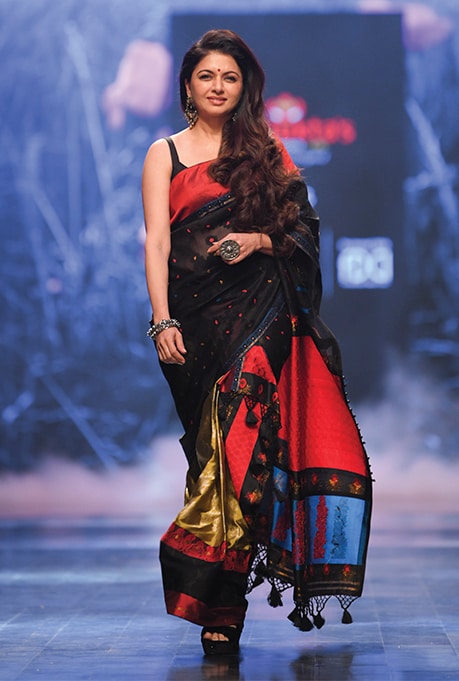
As culture and diversity are the buzzwords of the century, fashion from the Northeast leaves us in awe of its mix of couture and tradition. A mix which represents its richness and yet redraws boundaries to reaffirm a thrust on contemporary modes of living and consumption and a commitment towards building a sustainable future.
The multitude of fashion labels wearing the signature of brand ‘Northeast’ dives into the deep-rooted terrains of weaves and heritage textiles such as Eri, also called ‘peace’ or ‘Ahimsa’ silk. Several handloom fabrics are reinterpreted and upcycled into smart Western wear and accessories, reed baskets and banana fibre lifestyle products, streetwear adorned with original art, beaded and Baroque pearl jewellery, and so much more! The process reflects a contemporary design thinking, which meaningfully carves an aspirational and futuristic identity of the Northeast beyond the trenches of heritage imbued with local history and folklore. This has empowered a nuanced narrative of the Northeast in India and beyond, an image which is at the intersection of smart commerce, conscious fashion and technological prowess.
Sanjukta Dutta, a world-renowned designer, is noted for her flawless Mekhela Chador creations that showcase Assamese silks and traditional needlework in her own distinct style. The indigenous attire, Mekhela Chador – a traditional sarong worn by Assamese women – features exquisite and long- lasting decorations. Dutta has made sure that the traditional Mekhela stays up to date with new trends so that millennials want to wear it more often. “While the Mekhela Chador is well-known in the Northeast, it could not establish itself elsewhere, especially not as designer wear. My attempt was to change its image and showcase its convenience and beauty. The Northeast has an offbeat sense of style with its inhabitants treating clothes as an expression and extension of who they are as individuals,” says the designer.
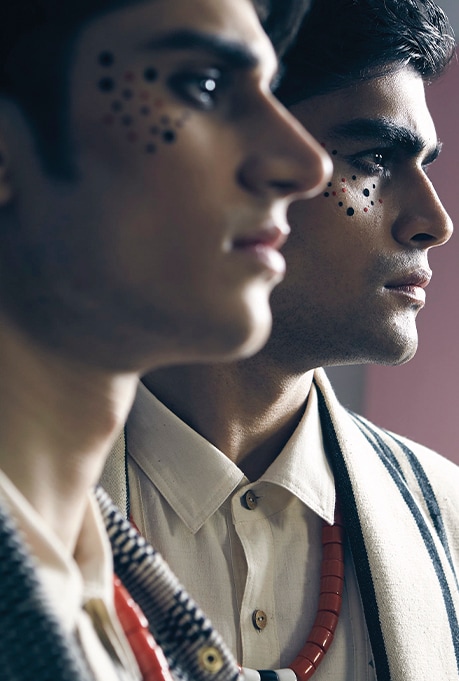
Showcasing the label at various fashion weeks such as the prestigious New York Fashion Week, Lakmé Fashion Week, and many more, has helped Dutta reach closer to the goal of making the Mekhela Chador a global piece of clothing.
Jenjum Gadi, an Arunachal Pradesh native, has started working with Nagaland’s loin-loom weaves. It is made up of a non-mechanical process in which the cloth is woven onto a bamboo loom strapped over the wearer’s lower back. It’s a piece of clothing stratagem used by several tribes in the Northeast.
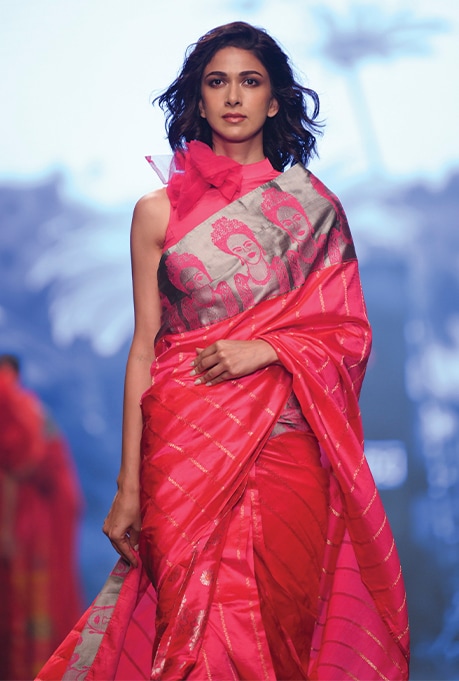
From farming cotton to extracting colours, weavers in the Northeast handle the most complex parts of the weaving process. However, the region is plagued by the lack of a consistent supply chain. Here, self-sufficiency is the only
While the Mekhela Chador is well-known in the Northeast, it could not
establish itself elsewhere, especially not as designer wear. My attempt
was to change its image and showcase its convenience and beauty.
SANJUKTA DUTTA
means to cut costs, while preserving quality. Textiles and local garments are one of the most widely recognised markers of indigenous communities and cultures. Revealing both similarities and distinctions among the ethnic communities, the ethnic groups’ traditional apparel plays an integral part in displaying their identity. Weaving techniques differ according to geography and group. Each ethnic group has its own design and colour scheme. Textile themes and designs are interwoven with the rituals and religious practices of the people of Northeast India. Textiles are made from various materials, including cotton, wool, Endi, Muga, orchid skin, and animal hair.
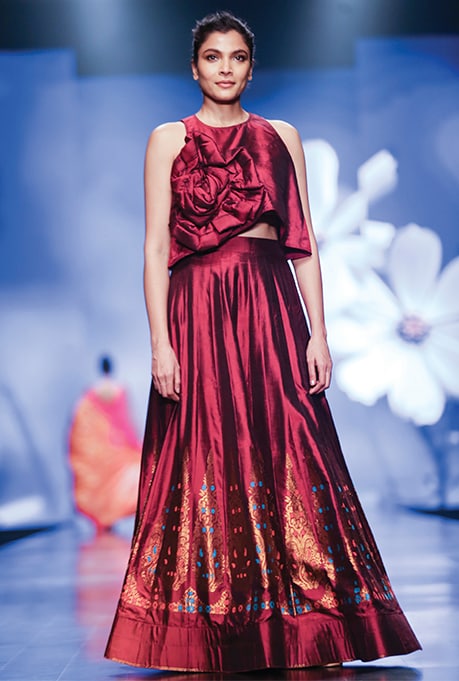
Jenjum Gadi used tiny loin-loom strips to convert intricate traditional designs into a simple geometric pattern, keeping the textile’s spirit alive without making it seem ordinary. His styles include fringed jackets with waterfall necks and contrast pockets. Models are seen sashaying the ramp wearing Gadi’s soft-collared tasselled shirts and wide pants. Traditional jewellery and woven bags are among the accessories.
“Northeast fashion’s biggest influence is from street style and K-pop and K-dramas (Korean pop/Korean dramas) as they find it more relatable because of the lack of their own representation in Bollywood,” explains Gadi. Gadi, who founded his label in 2012, sells his products through multi-designer boutiques in Delhi, Mumbai, and Kolkata. The designer is also exploring more retail options in Bengaluru and Chennai. Later this year, he plans to present the collection at pop-up stores around India. Gadi feels that fashion has created new doors for individuals from the region. His focus is on working with more weavers and textiles from the Northeast, particularly Arunachal Pradesh.
“Their style is original and unadulterated by typical trend forecasts. People of the Northeast bring up their own personalities through their clothing. Northeast street style fashion is very fresh and experimental and it is not limited by binary dressing codes, as you will see men wearing traditional shawls on bomber jackets or pairing a cowboy hat with traditional beads around it. Northeastern states are the fashion paradise of our country and you will be amazed with their self-styled layering of whatever clothes that are available. Their mix and match of traditional and Western style is head-turning in big metropolitan cities like Delhi and Mumbai”, says Gadi. He adds, “Their urge of experimenting brings out not only the best of bold fashion in terms of clothing but in hairstyles too.”
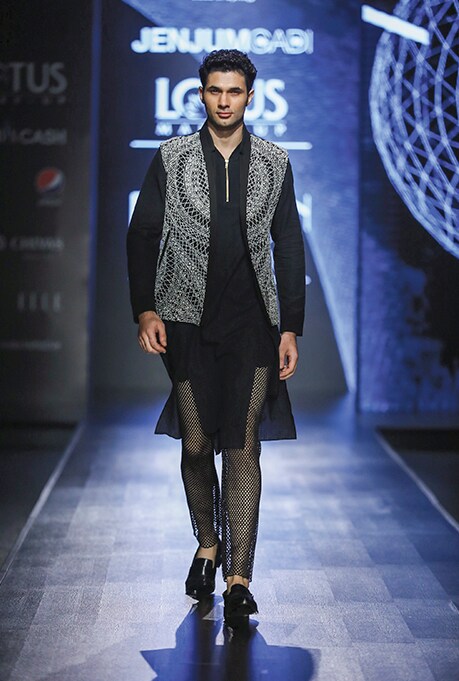
To add to the repertoire of the unbridled style quotient of Northeast India, we cannot help but notice the myriad melange of hip hop, preppy, rock, punk, et al. The region is influenced by Western culture and lately and evidently, K-pop.
The new generation of fashion designers from the Northeast are not only powering a multicultural India on the global fashion map but are also breaking free and redefining boundaries of conventional clothing often determined by society’s standards. For instance, it’s a common notion that lighter colours (pale blue, pastel pink, white) work best on dark skin tone and darker colours (navy blue, brown, dark green) work best on light skin tone. However, head to the Northeast and you would see the happy freedom of no-rule colours that thrive on a culture of creativity sans prejudice. The work of new-age designers from the Northeast represents the coming together of indigenous traditions and wearable art. We can only hope that it boosts the local economy and brings novel entrepreneurial innovations.
Northeast fashion’s biggest influence is from street style and K-pop and K-dramas (Korean pop/ Korean dramas) as they find it more relatable because of the lack of their own representation in Bollywood.
JENJUM GADI
Text By: Aishwariya Chattoraj